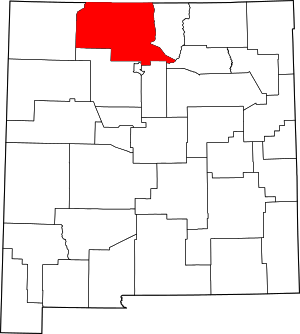Española, New Mexico
Española /ɛspənˈjoʊlə/ is a city primarily in Rio Arriba County, New Mexico, in the United States. A portion of the central and eastern section of the city is in Santa Fe County. Founded as a capital for Nuevo México in 1598 as San Juan de los Caballeros, it was renamed Española in 1880 when it became a railroad village, the city was officially incorporated in 1925. It has been called the first capital city in the United States.[5] At the 2010 census, the city had a total population of 10,495.[3] Española is within the Albuquerque–Santa Fe–Las Vegas combined statistical area.
Española | |
|---|---|
.png) Skyline view from the city's Industrial Park | |
 Seal | |
| Etymology: Founded as San Juan de los Caballeros, as capital of Nuevo México for Española (Spanish)[1] | |
| Nickname(s): "The Low Rider Capital of The World", Spaña, Espa | |
| Motto(s): The heart of northern New Mexico…where cultures unite. | |
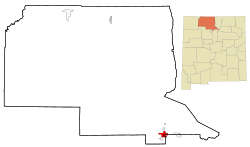 Location of Española, New Mexico | |
 Española Location in the United States | |
| Coordinates: 36°0′7″N 106°3′53″W | |
| Country | United States |
| State | New Mexico |
| County | Rio Arriba, Santa Fe |
| Founded | 1598[1] |
| Incorporated | 1925 |
| Named for | See history section |
| Government | |
| • Type | Mayor-council government |
| • Mayor | Javier E. Sánchez (R) |
| • City Council | Councilors
|
| • State House | Representatives
|
| • State Senate | State senators
|
| • U.S. House | Representative
|
| Area | |
| • Total | 8.34 sq mi (21.61 km2) |
| • Land | 8.22 sq mi (21.30 km2) |
| • Water | 0.12 sq mi (0.31 km2) |
| Population | |
| • Total | 10,495 |
| • Estimate (2019)[4] | 10,044 |
| • Density | 1,221.60/sq mi (471.64/km2) |
| ZIP codes | 87532, 87533 |
| Area code(s) | 505 |
| FIPS code | 35-25170 |
| GNIS feature ID | 928729 |
| Website | Official website |
History
Etymology
Española was referred to as La Vega de los Vigiles (Vigils' Meadow) before the presence of railroads.[6] It is believed that the town that began as Española was named by railroad workers. At the time of railroad construction, a small restaurant in the area was nicknamed "La Española". This was because of the large presence of Spanish women in the area. The name became official by 1900 and Española became a small railroad town. Before the railroads, this is where Spanish and Native American people had settled for hundreds of years, making a living from farming along the Rio Grande.[7]
Spanish settlement
The Española area (known as the "San Juan Valley" to the early Spaniards) is described as the first European-founded capital of the "New World". This designation refers to a capital within the boundaries of the United States since Santo Domingo in the Dominican Republic predates the establishment of Española by 100 years as a European-established capital in the Americas. The region was explored in 1598 by Don Juan de Oñate who declared the area a capital for Spain. Oñate arrived in the Española area on July 11, 1598, at the confluence of the Chama River and the Rio Grande, where he established a camp at a place then called Yunque-Yunque. He created the Spanish settlement in an area already inhabited by indigenous descendants of the Anasazi.[8] Almost a century later, near the same region, Don Diego de Vargas established his villa at Santa Cruz.[9]
Railroad era

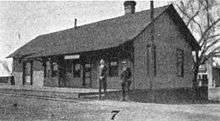
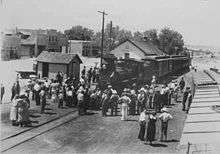
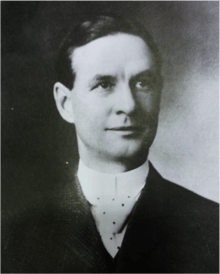
Prior to the arrival of the narrow gauge Denver and Rio Grande Western Railroad (Chili Line) in 1880, the hamlet on the west-side of the Rio Grande was known as La Vega de los Vigiles in reference to the Vigil family who initially settled that area. The earliest document found indicates that La Vegas de los Vigiles had been populated by 1751, over 100 years before the Chili Line's arrival. With the coming of the railroad the name of the hamlet was changed to Española. The Chili Line running predominantly through the Rocky Mountain region announced a route extension of its narrow gauge into northern New Mexico. The line was built along the Rio Grande, and later was known as the Chili Line. The route would extend into what today is the downtown Española area, and the railroad began selling lots in the area. Anglo merchants, mountain men, and settlers slowly filtered into Española.[10] Frank Bond and his brother George, who were Canadian emigrants, would later arrive in the city. Together they established the state's largest mercantile and a multi–million dollar wool empire. With them came economic growth and prominence. Española was the headquarters for all the Bond family interests which included over 12 businesses across New Mexico.[11][12]
Many residents of the nearby town of Santa Fe were not happy with the decision and failure of connection of the railroad, prompting protest. The Española station, however, included an engine facility station along with a roundhouse and turntable so it could service the locomotives. The facilities were built but torn down or no longer in use after six years; plans for the town had changed.[13] The railroad would later reach Santa Fe to connect with the Atchison, Topeka and Santa Fe Railway in late 1887.
Frank R. Frankenburger, a business man born in Fort Scott, Kansas, was the first "elected" mayor; he was elected in 1923. The first mayor who was chosen in "popularity" was Frank Bond, in 1907. In 1925 Española was incorporated as a city.[14] As the population rose, there was a high demand for public education in the city. Española High School was established; it would be the largest school in the area for decades. The first high school in the area, however, was Santa Cruz High School. Two miles away from downtown Española, it opened in 1906 in the historic Santa Cruz area. Neither high school operates after a merger of school districts in 1975.[15]
The importance of the railroad began to lessen as minimal passenger traffic and low shipments forced the railroad to close in the early 1940s. Many locals would become unemployed and would follow the railroad to Santa Fe, Albuquerque and central Colorado for jobs. Española's population would fall dramatically and many homes in the downtown became abandoned. Most of the locals who remained would turn to farming as a way of life. Many people saw Española as another failed railroad town.[16] The city removed the railroad tracks and the train depot in the 1960s, and the railroads completely vanished.
When the Railroad Leaves Town, –Joseph P. Schwieterman[17]
American communities in the age of the rail line abandonment
Post-railroad
With the beginnings of Manhattan Project in nearby Los Alamos, many locals eventually found jobs at the Los Alamos National Laboratory (LANL). As much as nearly 9% of Española's population have been employed at LANL.
In the 1980s, many historical buildings and homes of historical significance were torn down for urban renewal. Española followed many other New Mexico cities in this trend, but in Española, it failed. More modern business began to move into town, but the growth of Española had now expanded east across the Rio Grande. Although several buildings of historical significance remain in downtown Española, many are unused or abandoned. Strip malls became visible in Española, the first being the 'Big Rock shopping center', founded by oil tycoon Roy Honstein.
In the 1990s, a controversial plan to build a "plaza" and mission church where many historic buildings once stood was up for consideration. The city agreed to the plan, and locals supported the plaza. Although a plaza never existed in Española before the railroads, it was built to pay tribute to the Spanish culture in the area.[18]
Recent history
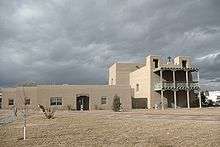
On September 18, 2008, Barack Obama, then a candidate for president, visited Española for a rally at the city's New Plaza in the Main Street district.[19][20]
Geography
Española is located at 36°0′7″N 106°3′53″W (36.001884, -106.064587).[21]
According to the United States Census Bureau, the city has a total area of 21.9 square kilometers (8.5 sq mi), with 21.7 square kilometers (8.4 sq mi) land and 0.2 square kilometers (0.077 sq mi) water, for a total of 0.83%.
Española lies at an elevation of around 5,595 feet (1,705 m) with much variance. It is in a valley nestled between the Jemez and Sangre de Cristo mountain ranges, and the meeting point of three rivers, the Rio Grande, the Rio Chama, and the Rio Santa Cruz.
Climate
Española has a borderline cool semi-arid climate (Köppen BSk)/cool desert climate (BWk). The main Española weather station is hotter and drier than nearby cities due to relatively lower altitude, lying over 1,300 feet or 400 metres lower than Taos or county seat Tierra Amarilla.
July is the hottest month, with an average high of 91 °F or 32.8 °C. The highest recorded temperature was 107 °F or 41.7 °C in 2003. The average coolest month is January at 45 °F or 7.2 °C. The lowest recorded temperature was −38 °F or −38.9 °C in 1971. The maximum average precipitation occurs in August with an average of 1.90 inches (48 mm).
| Climate data for Española, New Mexico | |||||||||||||
|---|---|---|---|---|---|---|---|---|---|---|---|---|---|
| Month | Jan | Feb | Mar | Apr | May | Jun | Jul | Aug | Sep | Oct | Nov | Dec | Year |
| Record high °F (°C) | 67 (19) |
75 (24) |
84 (29) |
88 (31) |
98 (37) |
105 (41) |
107 (42) |
103 (39) |
99 (37) |
89 (32) |
84 (29) |
72 (22) |
107 (42) |
| Average high °F (°C) | 45 (7) |
52 (11) |
60 (16) |
69 (21) |
78 (26) |
88 (31) |
91 (33) |
87 (31) |
81 (27) |
72 (22) |
58 (14) |
47 (8) |
69 (21) |
| Average low °F (°C) | 14 (−10) |
20 (−7) |
26 (−3) |
33 (1) |
41 (5) |
50 (10) |
57 (14) |
55 (13) |
47 (8) |
34 (1) |
24 (−4) |
15 (−9) |
35 (2) |
| Record low °F (°C) | −38 (−39) |
−18 (−28) |
0 (−18) |
14 (−10) |
17 (−8) |
28 (−2) |
35 (2) |
37 (3) |
25 (−4) |
10 (−12) |
−21 (−29) |
−16 (−27) |
−38 (−39) |
| Average precipitation inches (mm) | 0.40 (10) |
0.40 (10) |
0.60 (15) |
0.60 (15) |
0.70 (18) |
0.70 (18) |
1.60 (41) |
1.90 (48) |
1.20 (30) |
0.90 (23) |
0.60 (15) |
0.50 (13) |
10.1 (256) |
| Source: weather.com[22] | |||||||||||||
Air quality
According to the 2011 annual report by the American Lung Association, the Santa Fe–Española CSA (metropolitan area) has the cleanest ozone layer in the country (ranked #1), cleanest area in the country for 24-hour particle pollution (ranked #1) and cleanest area in the country for annual particle pollution (ranked #2).[23]
Demographics
| Historical population | |||
|---|---|---|---|
| Census | Pop. | %± | |
| 1890 | 398 | — | |
| 1900 | 1,405 | 253.0% | |
| 1910 | 1,802 | 28.3% | |
| 1920 | 2,412 | 33.9% | |
| 1930 | 4,269 | 77.0% | |
| 1940 | 2,984 | −30.1% | |
| 1950 | 2,489 | −16.6% | |
| 1960 | 3,472 | 39.5% | |
| 1970 | 7,923 | 128.2% | |
| 1980 | 8,127 | 2.6% | |
| 1990 | 8,828 | 8.6% | |
| 2000 | 9,504 | 7.7% | |
| 2010 | 10,495 | 10.4% | |
| Est. 2019 | 10,044 | [4] | −4.3% |
| U.S. Decennial Census[24] | |||
2000 census
At the census[25] of 2000, there were 9,688 people, 5,751 households, and 4,569 families residing in the city. The population density was 1,155.4 people per square mile (446.4/km2). There were 5,107 housing units at an average density of 189.2/square kilometer (489.8/square mile). The racial makeup of the city was 67.55% White, 0.58% African American, 2.86% Native American, 0.14% Asian, 0.06% Pacific Islander, 25.56% from other races, and 3.25% from two or more races. 84.38% of the population were Hispanic or Latino of any race.
There were 5,751 households, of which 35.6% had children under the age of eighteen living with them, 42.5% were married couples living together, 18.5% had a female householder with no husband present, and 31.5% were non-families. 26.2% of all households were made up of single individuals, and 9.7% had someone living alone who was sixty-five years of age or older. The average household size was 2.56 and the average family size was 3.08.
In the city, the population was spread out, with 27.8% under the age of 18, 9.7% from 18 to 24, 28.1% from 25 to 44, 22.1% from 45 to 64, and 12.3% who were 65 years of age or older. The median age was thirty-four years. For every 100 females there were 95.3 males. For every 100 females aged eighteen and over, there were 94.6 males.
The median income for a household in the city was $27,144, and the median income for a family was $32,255. Males had a median income of $25,558 versus $23,177 for females. The per capita income for the city was $14,303. 21.6% of the population and 16.5% of families were below the poverty line. Out of the total population, 28.4% of those under the age of eighteen and 15.1% of those sixty-five and older were living below the poverty line.
2010 census
As of the census[25] of 2010, there were 10,224 residing in the city.
The racial makeup of the city was:[26]
- 8.8% White (alone)
- 0.3% Black or African American
- 2.3% Native American
- 1.0% Asian
- 0.1% from other races
- 0.4% Multiracial (two or more races)[27]
- 87.1% of the population were Hispanics or Latinos (of any race)[27]
Economy
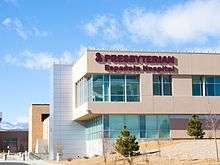
| Largest Employers in Española | |
|---|---|
| 1 | Los Alamos National Laboratory |
| 2 | Española Public Schools |
| 3 | Presbyterian Healthcare Services |
| 4 | Akal Security |
| 5 | Northern New Mexico College |
| 6 | Northern Pueblos Gaming Council |
| 7 | Walmart |
| 8 | Lowe's |
| 9 | City of Española |
| 10 | Rio Arriba County |
The Los Alamos National Laboratory is the largest employer in Española; it accounts for over 12% employment of residents. The education sector is the second largest employer, the Española Public Schools is the 16th largest school district in New Mexico. Recently, Northern New Mexico College has expanded its degree programs and made massive improvements to its campus, adding a new library and a new School of Education. Larger local businesses include Akal Securities Inc, a security company that employees over 500 people.[28]
Española has seen much commercial development on Riverside Drive, the city's secondary main road. Retail and eatery chains such as Lowe's, Chili's and GameStop, are anchors of a massive shopping square located next to Wal-Mart which came into the city in 1999. CVS/Pharmacy and Petsense also added locations in Española.[29]
Plaza De Española
The fountain at Plaza de Espanola was designed as a replica of the Alhambra. The plaza is home to the Convent Mission, administered by the Episcopal Church.
Telecommunications
Satview Broadband, headquartered in Reno, is the local cable television company. Due to a legal dispute with Jemez Mountains Electric Cooperative, Satview Broadband has suspended services in Española as of March 2016.[30] The city is served by several satellite TV services and is served by Windstream Communications for telecom and broadband service.
Festivals and activities
Española's restaurants and convenience stores are popular with travelers between Santa Fe and northern communities, as well as with local people. The local fiestas are held in the summer to commemorate the Spanish colonization and introduction of Christian faith to the area. The fiestas include live New Mexico and/or country music, vendors and parades.
There are many locations near Española that provide for outdoor activity such as hiking, biking, and river sports like rafting and kayaking. Nearby winter sports include skiing (downhill and cross-country) and snowboarding.
Parks and recreation
Recreational facilities
- Penny Roybal Garcia (Ranchitos) Aquatic Center
- Richard L. Lucero Recreation Center
Major community parks
- Plaza de Española Park
- Vietnam Veteran's Memorial Park
- Ranchitos Park
- Valdez Park (dedicated in memory of Española native Phil Valdez)
Government
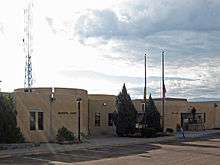
The city of Española is run by a mayor–council government system under Strong-mayor form. The mayor and eight-member city councilors from their respected districts are elected to a four-year term, elections are constant every two years, with no term limits. The mayor appoints a city manager who supervises department heads, prepares the budget, and coordinates departments.
Every two years during the organizational meeting, one council member is elected by a majority in the council to serve as mayor pro–tem, usually a member from the party that is in control of the council.
Elected officials
| Name | Position | Party reg. | Took office | Up for re–election |
|---|---|---|---|---|
| Javier E. Sánchez | Mayor | Republican | 2018 | 2022 |
| John L. Ricci | District 1 | Republican | 2018 | 2022 |
| Dennis Tim Salazar | District 1 | Democrat | 2004 | 2024 |
| John Ramon Vigil | District 2 | Democrat | 2018 | 2022 |
| Peggy Sue Martinez | District 2 | Democrat | 2012 | 2024 |
| Denise D. Benavidez | District 3 | Democrat | 2018 | 2022 |
| Manny Martinez | District 3 | Democrat | 2016 | 2024 |
| Justin J. Salazar Torrez | District 4 | Republican | 2018 | 2022 |
| Dorothy “Dee Dee” Valdez | District 4 | Democrat | 2020 | 2024 |
| Stephen S. Salazar | Municipal Judge | Democrat | 2003 | 2024 |
List of mayors
Mayors of Española Elected Mayor Party Registration Years served F.R. Frankenburger Republican 1925–1928 Tobias Espinosa Republican 1928–1932 Diego Salazar Republican 1932–1948 John Block Jr. Democrat 1948–1952 Joe E. Roybal Democrat 1952–1958 Cipriano Vigil Democrat 1958–1966 Epimenio Vigil Democrat 1966–1968 Richard Lucero Democrat 1968–1974 Santiago Martinez Republican 1974–1982 Consuelo S. Thompson Democrat 1982–1986 Richard Lucero Democrat 1986–1994 Ross Chavez Democrat 1994–1998 Richard Lucero Democrat 1998–2006 Joseph Maestas Democrat 2006–2010 Alice Lucero Democrat 2010–2018 Javier E. Sánchez Republican 2018–present
Education
Public schools
The City of Espanola is a part of the Espanola Public Schools district, with 6 of its 14 schools being located within the city.
High schools
Middle schools
- Carlos F. Vigil Middle School
Elementary schools
- Eutimio Tim Salazar III "Fairview" Elementary
- James H. Rodriguez "Española" Elementary
- Tony E. Quintana "Sombrillo" Elementary
Kindergartens
- Los Niños Kindergarten Center
Charter schools
- McCurdy High School
- La Tierra Montesori School of the Arts and Sciences
- Carinos de los Ninos Charter School
Private schools
- Holy Cross Catholic School
- Victory Faith Christian Academy
Colleges
Library
Espanola Public Library is located inside the Richard Lucero Center at 313 North Paseo De Oñate. Its collection is about 50,000 items.[31]
Notable people
- Harbhajan Singh Khalsa, founder of the 3HO movement, moved to Española
- Debbie Rodella, New Mexico state legislator, was born in Española.[32]
- Scott Tipton, Member of the U.S. House of Representatives from Colorado's 3rd district, was born in Española.[33]
See also
References
- "History of Española". Espanola, NM. Retrieved July 24, 2018.
- "2019 U.S. Gazetteer Files". United States Census Bureau. Retrieved July 27, 2020.
- Archived March 23, 2012, at the Wayback Machine
- "Population and Housing Unit Estimates". United States Census Bureau. May 24, 2020. Retrieved May 27, 2020.
- "City of Española Home Page". City of Española. Retrieved December 16, 2010.
- La Vega de Los Vigiles was a small farming community, today Española Archived September 27, 2013, at the Wayback Machine
- Archived September 27, 2013, at the Wayback Machine
- "History of Spanish settlers". Cityofespanola.org. Archived from the original on November 30, 2016. Retrieved August 3, 2014.
- Simmons, Marc, ‘’The Last Conquistador: Juan de Oñate and the Settling of the Far Southwest’’, University of Oklahoma Press, Norman, 1991 p. 108-108
- Rio Grande Sun, Historical Issue on City of Española, 1961–62
- "Full text of "New Mexico historical review"". Archive.org. Retrieved August 3, 2014.
- "RMOA - Document". Rmoa.unm.edu. Retrieved August 3, 2014.
- "Española, New Mexico". Ghostdepot.com. Archived from the original on February 4, 2015. Retrieved August 3, 2014.
- Rio Grande Sun, Historical Issue on City of Española, 1975
- Brief History of EVHS Archived August 3, 2008, at the Wayback Machine. Española Public School District. Retrieved on February 28, 2008.
- Denver Rio Grande Rail Road Closes, Santa Fe New Mexican, 1998
- Schwieterman, Joseph P. (2004). When the Railroad Leaves Town: American Communities in the Age of Rail Line Abandonment, Western United States. Kirksville, Missouri: Truman State University Press. p. 199. ISBN 978-1-931112-13-0.
- Española officials plan to revitalize downtown, Santa Fe New Mexican, 1997
- "Obama Visits Española". Albuquerque, New Mexico: KOAT 7 News. September 18, 2008. Archived from the original on July 23, 2011.
- "Obama Rally In Española". Santa Fe New Mexican. Santa Fe, New Mexico. September 18, 2008. Archived from the original on March 14, 2012. Retrieved July 12, 2020. Contains 3 articles.
- "US Gazetteer files: 2010, 2000, and 1990". United States Census Bureau. February 12, 2011. Retrieved April 23, 2011.
- "Monthly Averages for Española, NM". Retrieved August 20, 2008.
- "Santa Fe–Española, NM: State of the Air 2011 – American Lung Association". Stateoftheair.org. Retrieved August 3, 2014.
- "Census of Population and Housing". Census.gov. Retrieved June 4, 2015.
- "U.S. Census website". United States Census Bureau. Retrieved January 31, 2008.
- "Albuquerque (city), New Mexico". State & County QuickFacts. U.S. Census Bureau. Archived from the original on April 18, 2012. Retrieved April 23, 2012.
- "American FactFinder". Factfinder2.census.gov. October 5, 2010. Retrieved February 18, 2012.
- "Archived copy". Archived from the original on September 17, 2012. Retrieved June 14, 2012.CS1 maint: archived copy as title (link)
- "Archived copy" (PDF). Archived from the original (PDF) on October 5, 2011. Retrieved April 12, 2011.CS1 maint: archived copy as title (link)
- Writer, Barron JonesSUN Staff. "Co-op Interferes With Cable TV". Rio Grande SUN. Retrieved January 22, 2018.
- "Welcome to the Española Public Library". City of Española. Archived from the original on July 20, 2008. Retrieved December 30, 2008.
- "Debbie Rodella's Biography - The Voter's Self Defense System - Vote Smart". Project Vote Smart. Retrieved September 1, 2015.
- "Scott Tipton's Biography - The Voter's Self Defense System - Vote Smart". Project Vote Smart. Retrieved September 1, 2015.
External links
| Wikimedia Commons has media related to Española, New Mexico. |
| Wikivoyage has a travel guide for Española. |
